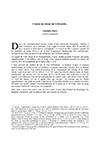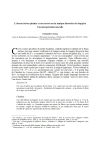Nil
« Comme un oiseau sur la branche... »
ENiM 10, 2017, p. 89-101.
 Perdus en plein désert, les bords du Nil sont un biotope prisé par de nombreuses espèces animales et végétales, amenées à coexister sur ce territoire restreint. Les plus opportunistes, à l’exemple des milans, devinrent rapidement des commensaux de l’Homme, aux yeux duquel ils représentent une figure familière du folklore animalier. Si fascinante soient-elles aux yeux des artistes de Pharaon, faune et flore sont pourtant perçues à travers le filtre de la cosmovision qui les dote d’une valeur symbolique plus ou moins forte et polysémique. Produit culturel, jusqu’où le dessin pharaonique pouvait-il être naturaliste ? Au-delà de l’identification d’un taxon précis, le renouveau des approches éthologiques de l’Histoire de l’art égyptien, permet de mieux saisir le fonctionnement du processus de sélection qui conduisent l’imagier à composer un contenu formel à l’attention de ses publics, attentifs à la réactualisation de ses mythes fondateurs.
Perdus en plein désert, les bords du Nil sont un biotope prisé par de nombreuses espèces animales et végétales, amenées à coexister sur ce territoire restreint. Les plus opportunistes, à l’exemple des milans, devinrent rapidement des commensaux de l’Homme, aux yeux duquel ils représentent une figure familière du folklore animalier. Si fascinante soient-elles aux yeux des artistes de Pharaon, faune et flore sont pourtant perçues à travers le filtre de la cosmovision qui les dote d’une valeur symbolique plus ou moins forte et polysémique. Produit culturel, jusqu’où le dessin pharaonique pouvait-il être naturaliste ? Au-delà de l’identification d’un taxon précis, le renouveau des approches éthologiques de l’Histoire de l’art égyptien, permet de mieux saisir le fonctionnement du processus de sélection qui conduisent l’imagier à composer un contenu formel à l’attention de ses publics, attentifs à la réactualisation de ses mythes fondateurs.
 Lost in the desert, the banks of the Nile are a biotope prized by many animal and vegetal species, brought to coexist in this restricted territory. The most opportunistic, like kites, soon became Humans’ commensals, for whom they are a familiar figure of their animal folklore. However they are fascinating into the eyes of Pharaoh’s artists, fauna and flora are perceived through the filter of cosmovision which gives them a symbolic value that is more or less strong and polysemic. As a cultural product, how far could pharaonic drawing be naturalistic? Beyond identifying a specific taxon, the renewal of ethological approaches to the History of Egyptian art, allows us to better understand the functioning of the selection process that leads the illustrator to compose a formal content to the attention of its audiences, attentive to the updating of its founding myths.
Lost in the desert, the banks of the Nile are a biotope prized by many animal and vegetal species, brought to coexist in this restricted territory. The most opportunistic, like kites, soon became Humans’ commensals, for whom they are a familiar figure of their animal folklore. However they are fascinating into the eyes of Pharaoh’s artists, fauna and flora are perceived through the filter of cosmovision which gives them a symbolic value that is more or less strong and polysemic. As a cultural product, how far could pharaonic drawing be naturalistic? Beyond identifying a specific taxon, the renewal of ethological approaches to the History of Egyptian art, allows us to better understand the functioning of the selection process that leads the illustrator to compose a formal content to the attention of its audiences, attentive to the updating of its founding myths.
 Consulter cet article (37802) -
Consulter cet article (37802) -  Télécharger cet article au format pdf (20629)
Télécharger cet article au format pdf (20629)
« L’oiseau bénou-phénix et son tertre sur la tunique historiée de Saqqâra. Une interprétation nouvelle »
ENiM 12, 2019, p. 247-280.
 Depuis la découverte en 1922 de la tunique historiée de Saqqâra, les études se sont succédé pour la dater et l’interpréter, sous différents angles. Dans ce document d’époque romaine, on a reconnu le bénou d’Héliopolis sur la butte de la création originelle. Mais l’iconographie de l’oiseau est influencée par le mythe gréco-romain du phénix, puisqu’un jeu de mots remplace le traditionnel héron cendré par un flamant rose, phoinikopteros, tel qu’il se voit aussi approximativement à la même époque sur la monnaie d’Hadrien intronisant le phénix comme symbole impérial ; il n’a pas un « bec de vautour » en référence au hiéroglyphe de l’année. Quant à la butte, son curieux décor ne montre ni « bandelettes sacrées », ni « flammes », ni « rochers » symbolisant les douze mois de l’année, mais treize plants de papyrus et les sept bouches du Nil, c’est-à-dire une image gréco-romaine du delta, dans une lecture topographique horizontale qui se superpose à la lecture verticale et temporelle.
Depuis la découverte en 1922 de la tunique historiée de Saqqâra, les études se sont succédé pour la dater et l’interpréter, sous différents angles. Dans ce document d’époque romaine, on a reconnu le bénou d’Héliopolis sur la butte de la création originelle. Mais l’iconographie de l’oiseau est influencée par le mythe gréco-romain du phénix, puisqu’un jeu de mots remplace le traditionnel héron cendré par un flamant rose, phoinikopteros, tel qu’il se voit aussi approximativement à la même époque sur la monnaie d’Hadrien intronisant le phénix comme symbole impérial ; il n’a pas un « bec de vautour » en référence au hiéroglyphe de l’année. Quant à la butte, son curieux décor ne montre ni « bandelettes sacrées », ni « flammes », ni « rochers » symbolisant les douze mois de l’année, mais treize plants de papyrus et les sept bouches du Nil, c’est-à-dire une image gréco-romaine du delta, dans une lecture topographique horizontale qui se superpose à la lecture verticale et temporelle.
 Since the discovery in 1922 of the decorated tunic of Saqqâra, the studies followed one another for its datation and interpretation, under various angles. On this document from the Roman era, one recognized the benu of Heliopolis on the primeval hill of the creation. But the iconography of the bird is influenced by the Graeco-Roman myth of the phoenix, because a pun allows to replace the traditional grey heron (ardea cinerea) by a pink flamingo, phoinikopteros, as it can also be seen, approximately at the same time, on Hadrian's currency inaugurating the bird as an imperial symbol ; it does not have « the beak of a vulture » in reference to the hieroglyph of the year. As for the mound, its curious decoration does not show a « sacred garland », neither « flames » nor « rocks » symbolising the twelve months of the year, but thirteen stems of papyrus and the seven mouths of the Nile, that is an Graeco-Roman image of the delta, in a horizontal topographic reading superimposed upon the vertical and temporal reading.
Since the discovery in 1922 of the decorated tunic of Saqqâra, the studies followed one another for its datation and interpretation, under various angles. On this document from the Roman era, one recognized the benu of Heliopolis on the primeval hill of the creation. But the iconography of the bird is influenced by the Graeco-Roman myth of the phoenix, because a pun allows to replace the traditional grey heron (ardea cinerea) by a pink flamingo, phoinikopteros, as it can also be seen, approximately at the same time, on Hadrian's currency inaugurating the bird as an imperial symbol ; it does not have « the beak of a vulture » in reference to the hieroglyph of the year. As for the mound, its curious decoration does not show a « sacred garland », neither « flames » nor « rocks » symbolising the twelve months of the year, but thirteen stems of papyrus and the seven mouths of the Nile, that is an Graeco-Roman image of the delta, in a horizontal topographic reading superimposed upon the vertical and temporal reading.
 Consulter cet article (36783) -
Consulter cet article (36783) -  Télécharger cet article au format pdf (18577)
Télécharger cet article au format pdf (18577)
ENiM 18 - 2025
4 article(s) - 11 mars 2025.
ENiM 1 à 18 (2008-2025) : 223 articles
4 020 137 téléchargements
8 334 581 consulations.
Index des auteurs

Mots clés

Derniers articles : 
Robert Steven Bianchi
Duplication and Continuity
(ENiM 18, p. 13-36 — 11 mars 2025) 
Frédéric Mougenot
Rénénoutet à la porte de la maison
(ENiM 18, p. 1-12 — 29 janvier 2025) 
CENiM - Mise en ligne des volumes épuisés : 
 Anne-Sophie von BOMHARD Décans égyptiens, CENiM 23, Montpellier, 2020 — (2020)
Anne-Sophie von BOMHARD Décans égyptiens, CENiM 23, Montpellier, 2020 — (2020) 
 Jean-Claude Grenier L'Osiris ANTINOOS, CENiM 1, Montpellier, 2008 — (26 décembre 2008)
Jean-Claude Grenier L'Osiris ANTINOOS, CENiM 1, Montpellier, 2008 — (26 décembre 2008) 
TDENiM - Mise en ligne des volumes épuisés : 
 Twitter
Twitter 3615578 visites - 9190 visite(s) aujourd’hui - 103 connecté(s)
© ENiM - Une revue d’égyptologie sur internet
Équipe Égypte Nilotique et Méditerranéenne - UMR 5140 - « Archéologie des Sociétés Méditerranéennes » (Cnrs) - Université Paul Valéry - Montpellier III























 Contact
Contact
 Abonnez-vous !
Abonnez-vous ! Équipe Égypte Nilotique et Méditerranéenne
Équipe Égypte Nilotique et Méditerranéenne UMR 5140 « Archéologie des Sociétés Méditerranéennes » (Cnrs)
UMR 5140 « Archéologie des Sociétés Méditerranéennes » (Cnrs) Université Paul Valéry - Montpellier III
Université Paul Valéry - Montpellier III